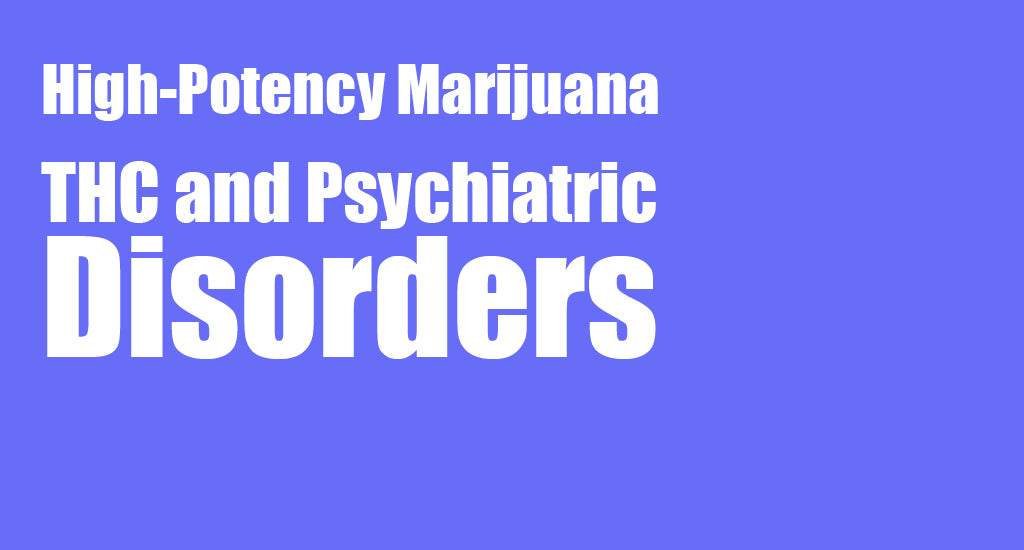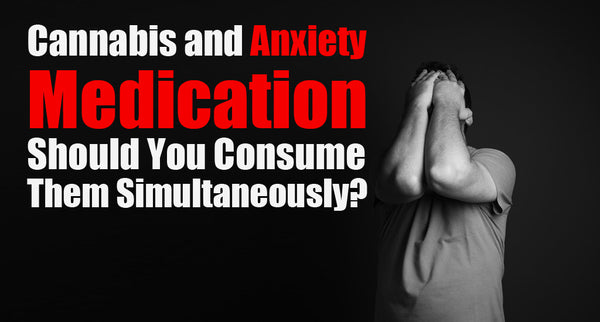April 05, 2024
In recent years, the legalization of cannabis in various states and countries has led to significant changes in the marijuana landscape. Among these changes is the advent of high-potency marijuana, which has sparked a growing concern among healthcare professionals and users alike. As the THC levels in cannabis products surge, so does the potential risk for cannabis-induced psychiatric disorders, a topic that has stirred considerable debate and research.
The Potency Problem: Why Stronger THC Could Mean Greater Risks
As the landscape of cannabis consumption evolves, the increasing potency of marijuana, particularly in terms of its THC content, has become a topic of concern for both users and healthcare professionals. THC, or tetrahydrocannabinol, is the main psychoactive component in cannabis, responsible for the 'high' sensation. Over the years, advancements in cultivation techniques have led to significantly stronger strains, raising questions about the associated health risks, especially concerning addiction and mental health.
-
Increased Addiction and Mental Health Risks: Studies have shown a link between high-potency cannabis and an elevated risk of addiction, as well as mental health issues such as psychosis and schizophrenia. This is particularly pertinent for frequent users and young people, who may be more vulnerable to these effects.
-
Balancing THC with CBD: It's suggested that users looking to mitigate the less desirable effects of THC, such as anxiety and paranoia, could opt for strains with a higher CBD to THC ratio. CBD (cannabidiol) is non-psychoactive and can help counteract some of THC's effects, providing a more balanced experience.
-
Dosing Considerations: For those using high-THC strains, starting with low doses can help avoid adverse side effects. Overconsumption, particularly for new users or through potent edibles, can lead to heightened anxiety, paranoia, and other negative experiencee.
-
Recognizing and Managing Side Effects: Potential side effects of high-THC cannabis include dry mouth, red eyes, increased appetite ("munchies"), sleepiness, and temporary impairments in memory and cognition. Strategies such as staying hydrated, choosing strains wisely, and controlling dosage can help manage these effects.
-
The Importance of Informed Choices: In jurisdictions where cannabis is legal, ensuring that consumers have access to accurate product information and are aware of the potential risks associated with high-THC products is crucial for safer use.
As cannabis continues to gain legal status in various regions, understanding the implications of its use, particularly with strains of higher potency, is critical for minimizing risks and promoting a healthier relationship with this complex plant. Engaging with cannabis cautiously, being informed about its effects, and prioritizing personal well-being are essential steps for any user.
A Historical Perspective: When More Became Too Much
As society's relationship with cannabis has evolved, so too has the plant itself, undergoing significant changes in potency that reflect broader cultural and technological shifts. This increase in THC content isn't merely a reflection of consumer demand for stronger products; it represents a complex interplay of agricultural innovation, market forces, and public health implications. Anecdotal accounts and scientific studies alike have charted this evolution, noting its potential consequences on users' mental and physical health.
-
Shifts in Cultivation Techniques: Advances in botany and technology have enabled growers to develop strains with significantly higher THC levels than were previously possible. These methods include selective breeding, hydroponics, and controlled lighting systems, which have all contributed to increasing the psychoactive potency of cannabis.
-
Changing Consumer Preferences: Over time, consumer demand has shifted towards more potent cannabis products. This trend is driven by both seasoned users seeking stronger effects and newcomers curious about the enhanced experiences advertised by dispensaries and cannabis companies.
-
Regulatory Influence: In regions where cannabis has been legalized, the regulatory environment has inadvertently favored the production of high-THC strains. Testing and labeling requirements often emphasize THC content, which can influence consumer choice and grower production priorities.
-
Public Health Concerns: The rise in potency has coincided with an increase in reports of cannabis-induced psychiatric conditions, such as anxiety, paranoia, and psychosis. Health professionals are particularly concerned about the impact of high-THC cannabis on young people, whose brains are still developing and who may be more susceptible to its adverse effects.
-
Need for Research and Education: Despite the growing body of anecdotal evidence and clinical research, there's still much to learn about the long-term impacts of high-potency cannabis. This underscores the need for continued research and public education efforts to ensure users are informed about the risks associated with these potent products.
The trajectory of cannabis potency highlights the need for a balanced approach to its cultivation, regulation, and consumption. As the cannabis industry continues to grow, understanding the implications of this increased potency will be crucial for safeguarding public health and ensuring responsible use.
Symptoms and Severity: Understanding the Impact
Understanding the impact of cannabis-induced psychiatric disorders requires a nuanced approach, considering the breadth of symptoms and their effects on daily life. These disorders encompass a spectrum, from transient feelings of discomfort to chronic, debilitating conditions. Early detection and management are key in mitigating the adverse consequences on an individual's mental health and overall well-being.
-
Range of Symptoms: The symptoms of cannabis-induced psychiatric disorders vary widely in their severity and manifestation. Users may experience mild anxiety and social paranoia, which, while unsettling, generally do not interfere significantly with daily functioning. However, at the more severe end of the spectrum, individuals may suffer from intense episodes of psychosis, characterized by hallucinations, delusions, and a profound disconnection from reality.
-
Impact on Daily Life: The severity of these symptoms can significantly impact an individual's quality of life, affecting their ability to work, maintain relationships, and perform daily tasks. In severe cases, the disruption caused by these psychiatric disorders can lead to long-term social isolation, financial instability, and deteriorating physical health.
-
Risk Factors: Factors such as genetic predisposition, age of first use, and frequency of consumption can influence the likelihood and severity of psychiatric disorders induced by cannabis. Young users and those with a family history of mental health disorders are at a particularly high risk.
-
Timely Intervention: Recognizing the early signs of cannabis-induced psychiatric disorders is crucial for prompt intervention. Symptoms to watch for include changes in behavior, mood swings, withdrawal from social activities, and unexplained paranoia or fear. Early intervention can significantly improve outcomes, potentially preventing the progression to more severe conditions.
-
Treatment and Support: Treatment options vary depending on the severity of the disorder but may include counseling, medication, and support groups. For individuals struggling with addiction, specialized substance use disorder treatments are available. Importantly, support from family, friends, and mental health professionals can play a critical role in recovery.
Cannabis-induced psychiatric disorders present a complex challenge, requiring awareness and understanding from users, healthcare providers, and the broader community. By recognizing the symptoms and understanding their potential impact, individuals can seek the help needed to manage these conditions effectively.
Mitigating the Risk: Strategies for Safer Consumption
With the evolving landscape of cannabis use, understanding how to mitigate the risks associated with its consumption, particularly of high-potency strains, is essential for maintaining health and well-being. Strategies for safer cannabis use are varied and can significantly reduce the likelihood of experiencing negative outcomes. Here are several approaches to consider for those looking to minimize risks:
-
Choose Lower THC Products: Opting for strains or products with lower THC concentrations can help manage the intensity of cannabis's psychoactive effects. CBD-dominant strains, for example, can offer therapeutic benefits without the high associated with THC.
-
Understand Personal Risk Factors: Awareness of personal and familial susceptibility to substance use disorders is crucial. Factors such as age, mental health history, and genetic predisposition can influence one's risk of developing cannabis-related issues.
-
Practice Moderation: Limiting frequency and dosage can prevent tolerance build-up and reduce the risk of dependence. For new users, starting with small doses and gradually increasing as necessary can help gauge tolerance levels and avoid negative side effects.
-
Stay Hydrated: Consuming plenty of water before, during, and after cannabis use can alleviate some of the common side effects such as dry mouth and dehydration, making the experience more comfortable.
-
Seek Professional Guidance: For individuals experiencing adverse reactions or symptoms of cannabis-induced disorders, consulting healthcare professionals can provide direction for treatment and support. Mental health professionals, in particular, can offer strategies for managing anxiety, paranoia, or other psychological effects.
-
Educate Yourself: Staying informed about the potential risks and safe use practices through credible sources can empower users to make informed decisions about their cannabis consumption. Education on the different strains, products, and their effects is also beneficial.
-
Avoid Mixing with Other Substances: Combining cannabis with alcohol or other drugs can intensify its effects and increase the likelihood of negative reactions. Users should be cautious about mixing substances without understanding the potential outcomes.
Adopting these strategies can contribute to a safer, more informed approach to cannabis use, allowing individuals to enjoy its benefits while minimizing potential harms.
Conclusion: A Call for Caution and Compassion
As we navigate the complexities of the cannabis landscape, it's important to approach the topic of high-potency marijuana with both caution and compassion. By fostering an environment of awareness, education, and support, we can mitigate the risks associated with these potent products and ensure a safer experience for all users.
Share




